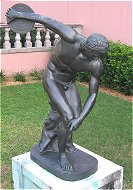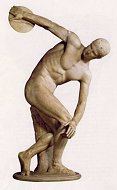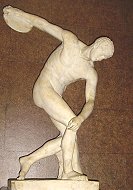Discus Thrower (Discobolus)Museum Label: Chiurazzi description: |
Subject info:
The Discobolus ("discus thrower") is a famous
Roman marble copy of a lost Greek bronze original of Myron completed
during the zenith of the classical period between 460-450 BC. Myron's Discobolus was long
known from descriptions:
"When you came in the hall," he said, "didn't you notice a totally
gorgeous statue up there, by Demetrios the portraitist?" "Surely you don't mean
the discus-thrower," said I, "the one bent over into the throwing-position, with
his head turned back to the hand that holds the discus, and the opposite knee slightly
flexed, like one who will spring up again after the throw?" . "Not that
one," he said, "that's one of Myron's works, that Diskobolos you speak
of..." (Lucian of Samosata, Philopseudes c. 18)
Its discovery in 1781, at a Roman property -Villa Palombara- of the Massimo family who installed it initially in their Palazzo Massimo delle Colonne then at Palazzo Lancelotti, made it instantly famous, though the Massimo jealously guarded access to it. The marble was almost fully in tact. A discus thrower is depicted about to release his throw. The moment captured in the statue is an example of rhythmos, harmony and balance. Myron is often credited as being the first sculpture to master this style. Naturally, as always in Greek athletics, the Discobolus is completely naked. His pose is said to be unnatural to a human, and today considered a rather inefficient way to throw the discus. Also there is very little emotion shown in the discus thrower's face. The other trademark of Myron depicted in this sculpture is how well the body is proportioned, symmetria.
|
|
After the discovery of the Discobolus Palombara a second notable Discobolus was excavated at Hadrian's Villa in 1790 and was purchased by the English antiquary and art dealer established in Rome, Thomas Jenkins, at public auction in 1792. The English connoisseur Charles Towneley paid him 400 for the statue, which arrived at the semi-public gallery Townley commissioned in Park Street, London, in 1794. It was bought for the British Museum, with the rest of Townley's marbles, in July 1805. However, the mutilated copy had been wrongly restored. The head faces the wrong way. The Ringling copy seems to be based on the Towneley sculpture (the head looking downwards) |
Other Roman copies in marble (without heads) have been recovered, and torsos that were
already known in the seventeenth century, but that had been wrongly
restored, have been identified as further repetitions after Myron's model. In the early
eighteenth century, Pierre- tienne Monnot restored a torso now recognized as an example
of Myron's Discobolus as a Wounded Gladiator who supports himself on his arm as he sinks
to the ground; the completed sculpture was donated before 1734 by Pope Clement XII to the
Capitoline Museums, where it remains.
The Palombrara Discobolus was instantly famous. In 1937 Adolf Hitler negotiated to buy it,
and eventually succeeded in 1938, when Galeazzo Ciano, Minister of Foreign Affairs, sold
it to him for five million lire, over the protests of Giuseppe Bottai, Minister of
Education, and the scholarly community. It was shipped by rail to Munich and displayed in
the Glyptothek; it was returned after the WW II in 1948 and placed in the Museo Nazionale
in 1953.
Prior to the statue's discovery the term Discobolus had been applied in the seventeenth
and eighteenth centuries to a standing figure holding a discus (compare Discophoros),
which Visconti identified as the Discobolus of Naukydes of Argos, mentioned by Pliny.
Examples of the Discobolus of Myron include:
- Discobolus Palombara now in the Museo Nazionale Romano, Rome. The Italian archeologist
Carlo Fea identified the sculpture as a copy from the original of Myron.
- Two copies found at Tivoli, 1791, one acquired by the Vatican Museum, the other, from
Hadrian's Villa, bought by Charles Towneley and is now in the British Museum, London. The
head was wrongly restored, as Richard Payne Knight pointed out, but Townley was convinced
his was the original and better copy.
- A copy discovered in 1906 in the ruins of a Roman villa at Tor Paterna in the royal
estate of Castel Porziana, now also in the Museo Nazionale Romano.
John Ringling liked the Chiurazzi copies so much, that he purchased
three of them - the others were placed at St. Armand and Ca' d'Zan. This last one has now
(2007) been installed at the south entrance of the new Searing wing.
Myron's Discus Thrower statue was originally called Discobolus and the original artist
that made him was one of the best sculptors of ancient Greece and lived in Athens in the
5th century BC. Considered by many to represent the perfect athletic form, Discobolos.
This Grecian work of art is renowed for its contribution to the contraposito form of
sculpture. Myron's Discus Thrower is one of the most famous classic Greek statues from
this period. Discobolus athlete engaged in the discus throw boasts vigorous and convincing
movement in a perfect made form. His flexing muscles and concentrated expression create a
strong impression.


